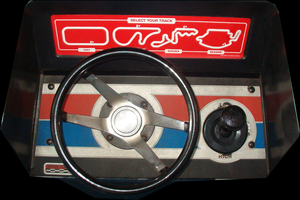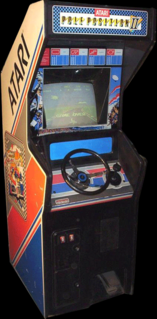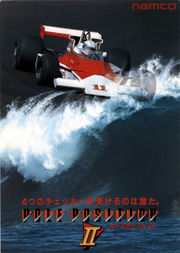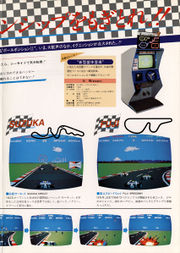Lost In Translation/Pole Position II
| Pole Position II | |
|---|---|
| Manufacturer | Namco |
| Released | 1983 |
| Control Method |
Dial Pedal 1 Button(s) |
| Main CPU | Z80 (@ 3.072 MHz) (2x) Z8002 (@ 3.072 MHz) MB8844 (@ 256.000 kHz) |
| Sound CPU | Stereo Namco (@ 48.000 kHz) Namco 52XX (@ 1.536 MHz) Discrete Custom |
| Video Details |
Raster (Horizontal) 256 x 224 pixels 60.61 Hz 3,840 Palette colours |
| Screens | 1 |
| ROM Info | 48 ROMs 234,048 bytes (228.56 KiB) |
| MAME ID | polepos2 · poleps2a · poleps2b |
About The Game
Pole Position II is a chase-view racing arcade video game.
Game action takes place at 4 different raceways - the Fuji Speedway in Japan, the Test Track (an oval track like Indy), the Seaside Speedway (with the Long Beach Pike in the background), and the Suzuka Speedway in Japan. The unique and picturesque scenery around each raceway adds exciting realism to each race!
The driver drives a Formula-1 race car on each track. Player controls consist of a steering wheel, a two-position gear shifter, an accelerator, and a brake pedal (on the Sit-Down cabinet). The first objective of the game is to finish the qualifying lap as quickly as possible. If the driver beats the time, he qualifies for the race. If he does not qualify, he drives the remainder of his time along the qualifying course.
As a qualifier, the driver is ranked according to his qualifying lap time, from position one (the pole position) to position eight. Then the driver's second objective is to race against the clock and other cars to finish the race laps as fast as possible, and to achieve the highest score possible. The driver earns points for passing cars, driving on the track, and finishing the race with time remaining. The time remaining from the Racing Lap is added to the extended lap time.
To start the Play Mode, a driver must first insert the correct number of coin(s) for a game (according to the coin dip switch settings, 1 coin/1 credit is the default for both 'Coin A' and 'Coin B' dips). Then the driver turns the steering wheel until the track he wants to drive on is highlighted in white. The Play Mode will begin when the driver steps on the accelerator. The driver's car will appear behind the starting line and a certain amount of time, in seconds ('Game Time' dip switch setting; the default is 90 seconds) will be on the clock. The car must finish the qualifying lap within the time allotted to be in the race. If the driver does not qualify, his car continues on the track until the 'Game Time' elapses.
If the driver has qualified, just before the race begins, the driver's car (flashing on the screen) is placed at the starting line with seven other cars. The position of the car depends on the position earned during the qualifying lap.
The starting lights flash from red to green, and the race begins. Racing hazards are other racing cars, sharp turns, water puddles, and road signs (all of these hazards also appear during the qualifying lap with the exception of water puddles). As the race progresses, more cars appear on the track. If the driver's car hits another car or a road sign, the driver's car is destroyed in an explosion. (Pole Position II adds flying debris to the visual effect.) The driver's car reappears in a few seconds and the race continues. Driving through water puddles or off the track slows down the driver's car considerably.
Experience will teach a driver which turns on which tracks require slight steering (because they're banked) and which turns require fast and forceful steering. He jockeys for position with the other racers, while keeping his eye on the clock at the top of the screen. When his time runs out, the race is over. If he has beaten the racing lap time and has seconds remaining, the remaining seconds are added to the extended lap time, which varies depending on the track and the 'Extended Rank' dip switch setting.
The top score achieved by a driver appears at the top of the screen. The time allotted for the lap is displayed under the top score. Increasing lap time (in seconds and hundredths of a second) and the speed of the car appears last. Each track has its own separate high score list.
Trivia
Released in October 1983.
Also licensed to Atari for US manufacture and distribution (December 1983). Approximately 2,400 units were produced by Atari.
The upright version of Pole Position II came in a standard Atari cabinet (similar to the "Asteroids"/"Lunar Lander" cabinet), with an altered control panel area. The side-art consisted of red, white, blue, and grey striped paint job, with an Atari logo, and a square sticker showing a race scene. While the marquee had a Pole Position II logo superimposed over a checker-board pattern. This is the exact same cabinet used in the original "Pole Position",the only thing that was changed was the marquee, and the outlines of the courses shown on the control panel. The control panel was done up in the same colours as the side, and featured an analogue steering wheel, and a two position shifter.
There was also a cockpit version of this game. This was one completely different than the original "Pole Position" cockpit. It shipped in a single piece, and had a clear window in the back for observers to watch the action. It had little in the way of decoration inside, but the exterior was completely covered in detailed race car scenes that were much more attractive than those on the original "Pole Position". The cockpit Pole Position II cabinet had both a gas pedal and a brake pedal, while the upright cabinets had only a gas pedal.
Lloyd Dahling holds the official record for this game on the 'Fuji' track with 75,390 points.
Jeff Peters holds the official record for this game on the 'Seaside' track with 75,390 points.
Jeff Peters also holds the official record for this game on the 'Suzuka' track with 75,660 points.
Jeff Peters also holds another official record for this game on the 'Test' track with 81,870 points.
Updates
- The Atari version has an extra dip switch setting ("Speed Unit") that allows the user to toggle between using the English system and the Metric system to measure the speed of the player's car (as shown on the upper-right corner during game play). By default, the game uses the Metric system. Namco's original version does not have this dip and exclusively uses the Metric system.
- At the start of the game in the Fuji and Suzuka tracks, a gray blimp with the Namco logo carries the white banner across the screen in the Namco version while a gray unmarked blimp carries the white banner across the screen in the Atari version. In the Test and Seaside tracks, a biplane carries the banner instead of the blimp on both Namco and Atari versions.
- The message on the banner is now displayed in red letters (in a different font from the original Pole Position game) with a blue outline.
- Instead of "Game Over", the Pole Position II logo spins into the screen after the game ends, fading into the title screen, which no longer shows a track or displays the distance of a full lap (now that there are four tracks to choose from).
- There are now billboards for '7-Eleven', 'Tang', and 'Dentyne' on all tracks in the Atari version, and various billboards including 'Pepsi', 'Marlboro', and 'Champion' in the Namco version.
- The Test and Suzuka tracks feature a 'Dunlop Formula SP' arch in Namco's version; this arch is replaced by a spectator bridge (with spectators watching the race from the bridge) in the Atari version.
- The sign above the cars at the start of the race says "Start". When the player completes a lap, the sign says "Namco" in the Namco version and "Goal" in the Atari version. (In the Atari revision of the original Pole Position game, the sign said "Fuji" when the player completed a lap.)
Scoring
- Points are scored for every foot of track driven.
- At the end of the game, 50 points are scored for each car the driver passed.
- Finishing the game awards 200 points for each second left on the timer.
Qualifying Lap Placement Bonus (Qualifying times vary depending on both the track and the 'Practice Rank' dip switch setting):
| Position | Points |
|---|---|
| Pole Position (1st place) |
4000 |
| 2nd place | 2,000 |
| 3rd place | 1,400 |
| 4th place | 1,000 |
| 5th place | 800 |
| 6th place | 600 |
| 7th place | 400 |
| 8th place | 200 |
Tips and tricks
Hints
- Avoid puddles and the sides of the track because these slow the driver down.
- Accelerate before the green light appears, and stay ahead of other racers.
- Drive the inside of the track to make the corners.
- Do not over steer (tracks are banked).
- Engine sound will cue the driver when to shift to high gear.
- When sliding, steer into the skid.
Easter Egg
- Enter service mode.
- Turn wheel to 04; Change the shifter from LO to HI.
- Turn wheel to 45; Change the shifter from LO to HI.
- Turn wheel to 55; Change the shifter from LO to HI.
- Turn wheel to 56; Change the shifter from LO to HI.
- Turn wheel to 91; Change the shifter from LO to HI.
'(c) 1982 NAMCO LTD.' will appear on the screen.
Series
- Pole Position [Upright model] (1982)
- Pole Position [Cockpit model] (1982)
- Pole Position II (1983)
- Final Lap (1987)
- Final Lap UR (1988)
- Final Lap Twin (1989, NEC PC-Engine)
- Final Lap 2 (1990)
- Final Lap 3 (1992)
- Final Lap R (1993)
- Final Lap 2000 (2000, Bandai WonderSwan)
- Final Lap Special (2001, Bandai WonderSwan Color)
Staff
- Sound
- Nobuyuki Ohnogi
Cabinet and Artwork
Ports
- Consoles
- Atari 7800 (1989)
- Sony PlayStation (1996, "Namco Museum Vol.2")
- Sony PlayStation 2 (2001, "Namco Museum")
- Sony PlayStation 2 (2005, "Namco Museum 50th Anniversary")
- Microsoft XBOX (2005, "Namco Museum 50th Anniversary")
- Nintendo GameCube (2005, "Namco Museum 50th Anniversary")
- Computers
- Commodore C64 (1988)
- PC [MS Windows, CD-ROM] (2005, "Namco Museum 50th Anniversary")
- Others
- Mobile Phones (2006)
Soundtrack Releases
| Album Name | Catalogue No. | Released | Publisher | Comments |
|---|---|---|---|---|
| The Return of Video Game Music | ALC-22004[1] | 1985-06-25 | Alfa | Cassette version. |
| The Best of Video Game Music | 32XA-66[2] | 1986-04-25 | Alfa | CD version. |
| The Return of Video Game Music | ALR-22004[3] | 1985-06-25 | Alfa | Vinyl version. |
| The Return of Video Game Music | SCDC-00122[4] | 2001-12-05 | Scitron Digital Content | CD version. |
| Namco Arcade 80's | SCDC-00272[5] | 2003-05-21 | Scitron Discs | CD version. |
| Legend of Game Music ~Premium Box~ | SCDC-00410~7[6] | 2005-03-24 | Scitron Digital Contents | 8 CD version. |
References
- ↑ The Return of Video Game Music (Cassette) at the VGMdb
- ↑ The Best of Video Game Music (CD) at the VGMdb
- ↑ The Return of Video Game Music (Vinyl) at the VGMdb
- ↑ The Return of Video Game Music (CD) at the VGMdb
- ↑ Namco Arcade 80's (CD) at the VGMdb
- ↑ Legend of Game Music ~Premium Box~ (CD) at the VGMdb









